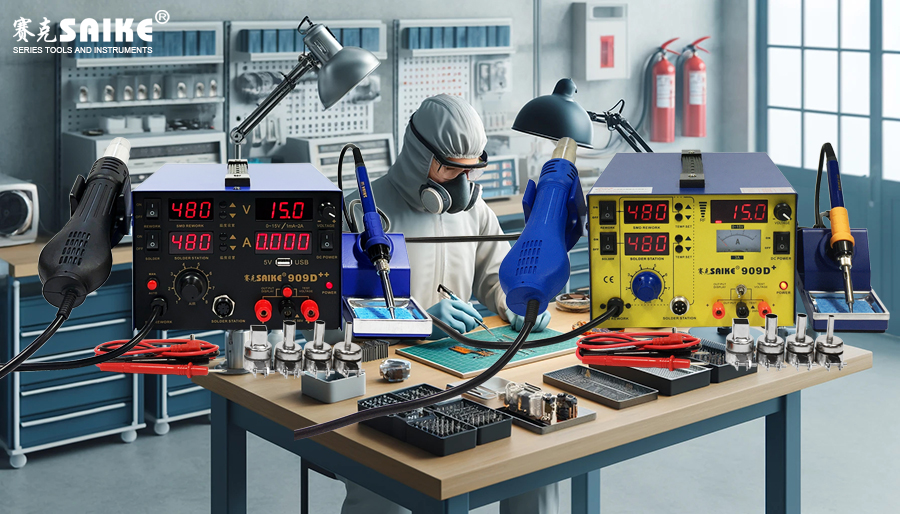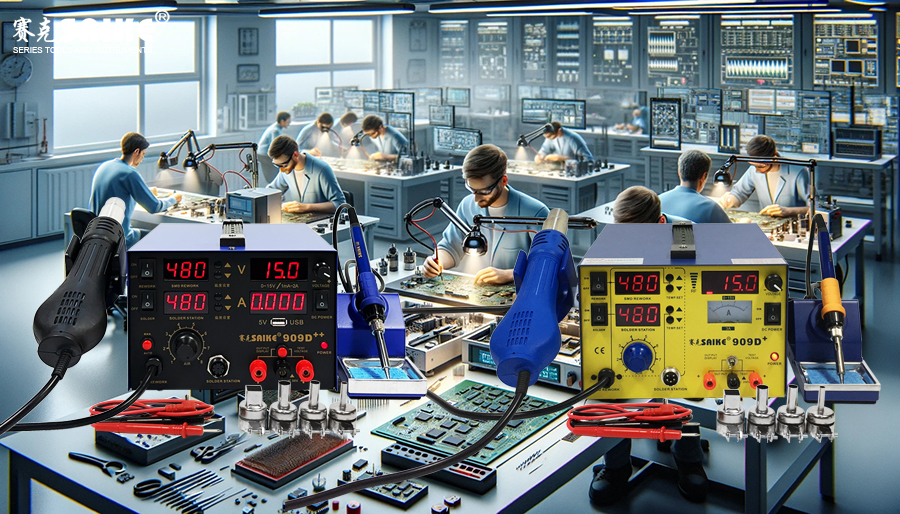
SK-YJ000RFSHY-KP 100026
Soldering station operation is a crucial step in electronic engineering, but it also entails many potential dangers. Therefore, understanding and implementing protective measures during soldering station operation is essential to ensure the safety of operators and the cleanliness of the work environment. This article will introduce in detail the protective measures that should be taken during soldering station operation.
I. Personal Protective Equipment
1.Protective Glasses
– Protect eyes from splashes of solder and harmful fumes.
– Ensure that the glasses meet the ANSI Z87.1 standard.
2.Protective Gloves
– Use heat-resistant gloves to prevent high-temperature burns.
– Ensure that the glove material is suitable for soldering operations without affecting flexibility.
3.Protective Clothing
– Wear anti-static overalls to avoid damage to electronic components caused by static electricity.
– Choose overalls made of high-temperature resistant materials to prevent burns.
4.Respiratory Protection
– Use a mask or respirator to prevent inhalation of harmful soldering fumes.
– In poorly ventilated environments, it is more effective to use a mask with an activated carbon filter.
II. Work Environment Protection
1.Ventilation
– Ensure good ventilation in the operating environment, preferably using a local exhaust system (such as a fume hood).
– Regularly inspect and maintain ventilation equipment to ensure its normal operation.
2.Workbench
– Keep the workbench clean and tidy, avoid clutter to reduce fire hazards.
– Use anti-static mats and ground wires to prevent electrostatic damage to components.
3.Fire Prevention Measures
– Equip the work area with fire extinguishers, especially those suitable for electrical fires (such as CO2 extinguishers).
– Regularly check the effectiveness and integrity of the fire extinguishers.
III. Safe Use of Soldering Station Equipment
1.Temperature Control
– Ensure that the soldering station temperature controller works normally to avoid burns and fires caused by excessive temperature.
– Use appropriate temperatures for soldering to avoid damaging components due to excessively high temperatures.
2.Power Management
– Use a power outlet with overload protection to prevent fires caused by excessive current.
– Turn off the soldering station power in a timely manner after the operation is completed to avoid prolonged power-on.
3.Regular Inspection and Maintenance
– Regularly inspect the power cord and plug of the soldering station equipment to ensure no damage.
– Maintain and replace aging equipment components to ensure normal equipment operation.
IV. Operating Norms and Training
1.Operating Norms
– Strictly follow the soldering operation specifications to avoid safety accidents caused by violations.
– Comply with the safety rules and regulations of the factory or laboratory, especially regarding soldering operations.
2.Training and Education
– Regularly conduct welding safety training to enhance the safety awareness and skills of operators.
– Training content should include equipment use, safety protection, and emergency response.
V. Emergency Handling
1.Burn Treatment
– In case of burns, immediately rinse the affected area with cold water for at least 15 minutes and seek medical attention.
– Avoid applying greasy substances to the wound to prevent infection.
2.Fire Handling
– In case of a fire, immediately use a fire extinguisher to put out the fire source and cut off the power supply.
– If the fire cannot be controlled, evacuate quickly and call the police.
3.Harmful Gas Leakage
– If harmful gases are detected leaking, immediately stop the operation, turn off the gas source, evacuate personnel, and ventilate the area.
– If symptoms of poisoning appear, seek medical emergency treatment immediately.
VI. Summary
Protective measures during soldering station operation involve not only the use of personal protective equipment but also encompass workplace protection, safe use of equipment, operating norms and training, and emergency handling. By fully understanding and strictly implementing these protective measures, safety accidents can be effectively reduced, protecting the safety of operators and ensuring the cleanliness of the work environment and the normal operation of equipment.


